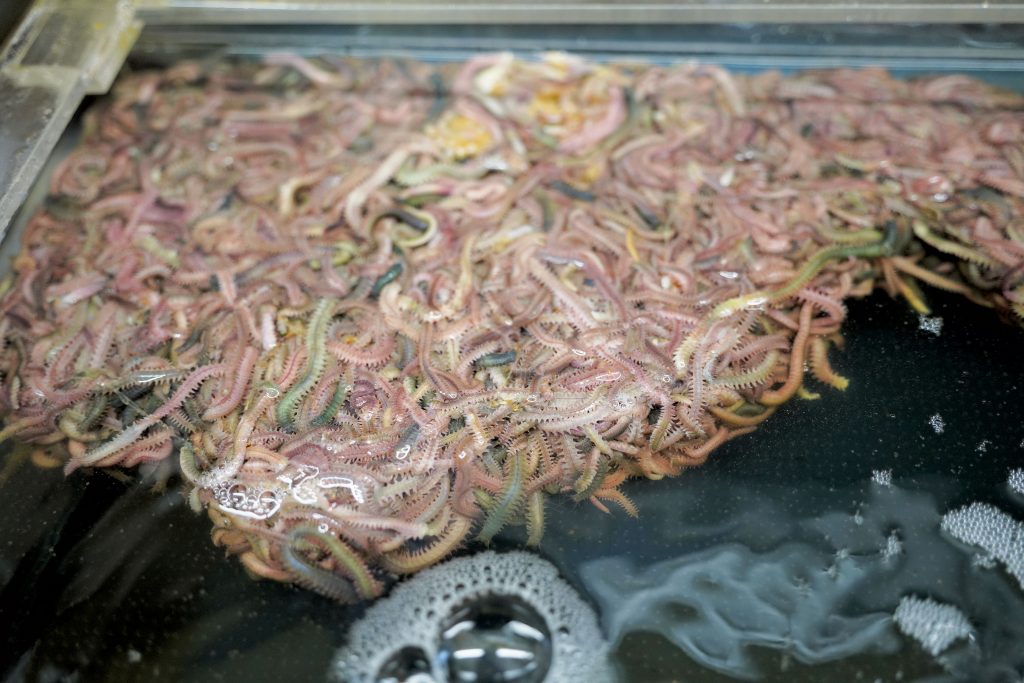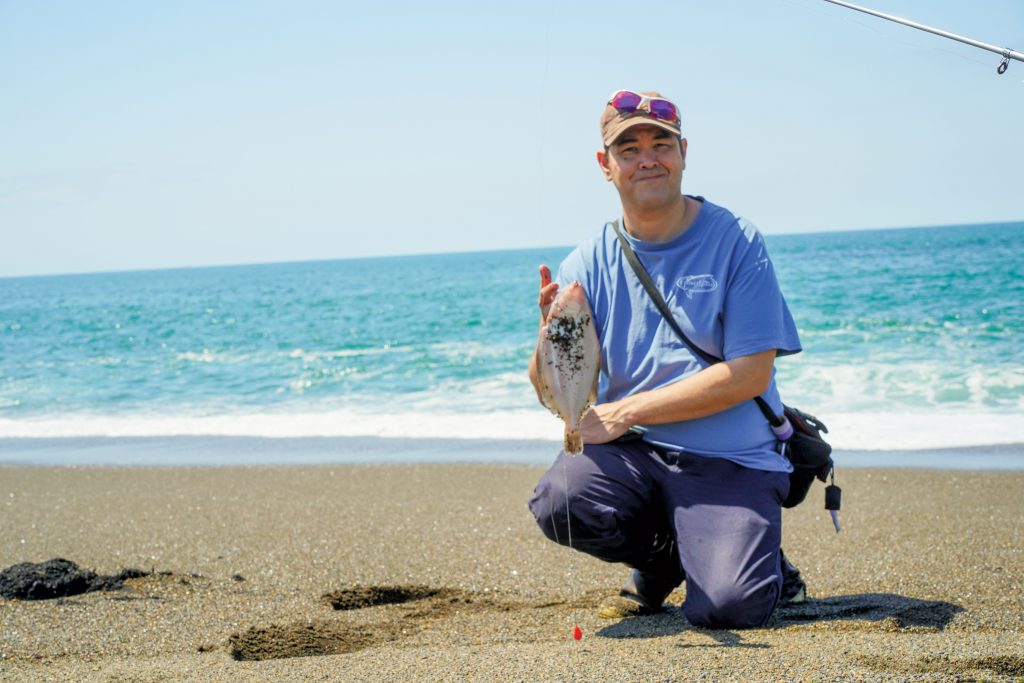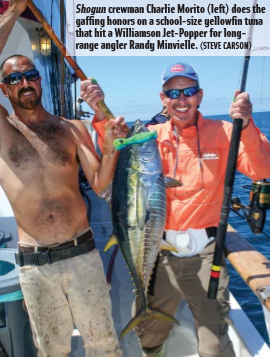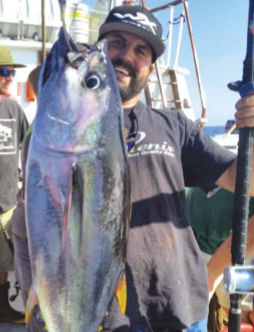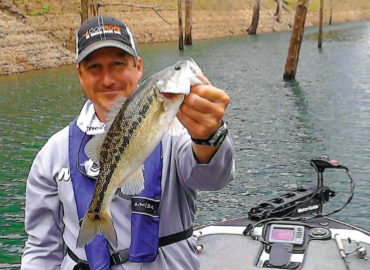Surf’s Up for a Beach Angler

LONG AGO FUEL FISHERMAN’S
SEARCH FOR NIBBLES ON FAR
SIDE OF THE PACIFIC
Whenever the California weather was good and my dad and I had the time, we would go surf fishing. A couple of rods and some jigs were all that we had to carry along with us. The light weight of the equipment helped if we had to walk any distance to the water. We didn’t have any one place we preferred; instead, we would drive along the beach looking for some type of structure. Sometimes it was a street water runoff outlet or a river mouth; others, we’d spot a group of rocks in the middle of a sandy beach. A couple of times Dad heard about certain spots from his friends where someone had caught a big fish. We fished broken, rotten piers and even the outlet to a power plant, and no, I never saw a three-eyed fish!Once we had arrived at our spot and dressed in shorts, we left our shoes in the car. Sand can get scorching hot in the California summer, so sometimes we had to run into the water to cool off our feet. Only then was I able to take in the scene: The gentle sound of the waves crashing against the sand and slowly melting and sliding back into the sea; seagulls chatting to each other as they fly overhead; the salty air swirling around as the cool ocean water laps at our feet.Over the years I’ve heard and seen many fish being caught from the California beach – from halibut to sharks, white seabass to barracuda. Though I only ever caught barred surf perch, I was still happy with that. My dad did catch a smallish halibut once and a short sand bass another time.Everything was catch and release for us when we went surf fishing, as we didn’t want to carry any fish around with us.I remember us trying different lures and baits from time to time – perhaps a fillet of anchovy or a piece of squid on a leadhead would finally get us that big halibut. Surely a flashy lure would get us a barracuda. One time we even brought out live bait and let it sit past the surf, hoping for a large fish to devour it. In the end it was always a grub-tail lure that caught the most fish. Since I’ve since moved to Japan, I wanted to experience this kind of fishing again.

(LANCE SAWA)
AFTER A YEAR OF not being able to go ocean fishing, I started looking into the fish counts and other local information as a reference point. A storm was over the area along the Sea of Japan, off the west coast of the island of Honshu, but right before it touched land a large number of fish were being caught along the beaches.The catch was diverse too: some flounder, rockfish and, most of all, sillago, also known as Japanese whiting. Sillago are great to eat; they have soft white flesh, which gets eaten with the skin most of the time because the flesh will fall apart when filleted.By the next day the storm had blown itself out, so I left for the hour-and-a-half drive to the beach in Joetsu, Niigata Prefecture, north of Tokyo. In the mirror I could see the snow still on my local mountains. I stopped once along the way at Joshuya bait and tackle shop to pick up supplies. The store had even more information about the local conditions and details about all the fishing that was in season, including surf fishing.As I was looking and somewhat confused by the sheer number of choices, I happened to start chatting with a woman who was a boat captain. She helpfully showed me a few things and pointed me toward some good spots where she liked to fish. When the subject of bait came up, she firmly talked only about artificials. The perinereis clam worms – or rag worms – normally used for bait were a bit too much for her. After I thanked her, we went our separate ways and then I bought some rag worms with one of the advertised rigs.
WITH FRESH BAIT AND a popular rig to fish with, I set out for the location my new friend suggested. It was a large stretch of beach just beyond a popular fishing pier. There were many people fishing, perhaps because the storm was finally gone and they could once again get out on the water.Driving along the beach there were plenty of places with structure and even parking spots, but also lots of other people out fishing. I don’t like crowding other people, so I continued to drive down the shoreline until I saw a little beach road. It looked to be going toward the water and I took the chance. I thought, worse comes to worst I’d just have to turn around.The little beach road took me along a small farm and past more little beach roads, but sure enough, it ended right at the water’s edge. There was a little breakwall and raised parking – a perfect location.Japan’s ocean water is a bit too cold for me and I decided to wear boots rather than going barefoot like my dad and I did back in California. Japanese surf fishing setups are also a bit different than what I used to use. The weight is on a wire that separates the hook line from the main line to decrease tangles.When I got down to the water it was just as cold as I remembered it, but with fresh bait on the new-to-me rig, I made my first cast. I had read that the best method for surf fishing was to do a run and gun, which is simply just walking the beach as I used to do so often on the other side of the Pacific. Cast a few times, and if you don’t have any luck, then you just move down the beach and keep doing that until you catch something or run out of sunlight.I got nothing over a couple casts, changed the bait and moved down the beach a bit. I’d cast and slowly drag the line in, then wait for anything chasing the bait to bite.I dragged the line and waited, then I got a bite but I was a bit too fast to set the hook and the fish and bait were gone. This was my first time using rag worms, but they aren’t too different from earthworms. The worms’ two large teeth sticking out were a bit frightening, but I didn’t get bit. Of course, the fish hadn’t bit enough of the bait in the water either!
I TRIED ONCE MORE. With fresh bait on the hook I began to slowly drag the setup back in. I got another bite in the same area, but this time I waited a bit too long and whatever was on the other end stole the bait. Time to rinse and repeat: put on a fresh bait, cast, drag and wait.And I got another bite, but this time I hooked into it. The fish and I had a short fight and soon a little flounder came out of the surf. After all those catch-and-release moments with my dad, I knew my son Nico would love to see it, so the fish went into a bucket to take home.After all that excitement, no more fish were interested in my rag worms in that spot, so I continued to walk the beach until I began to get a bit too far from the car. I started heading back and a few more times on the way I tried more casts, but there was no more action. I guided the car back up the beach road and decided to try the first area again, the one that had been so busy when I first arrived. There were less people now, making it worth my time to give it a shot.
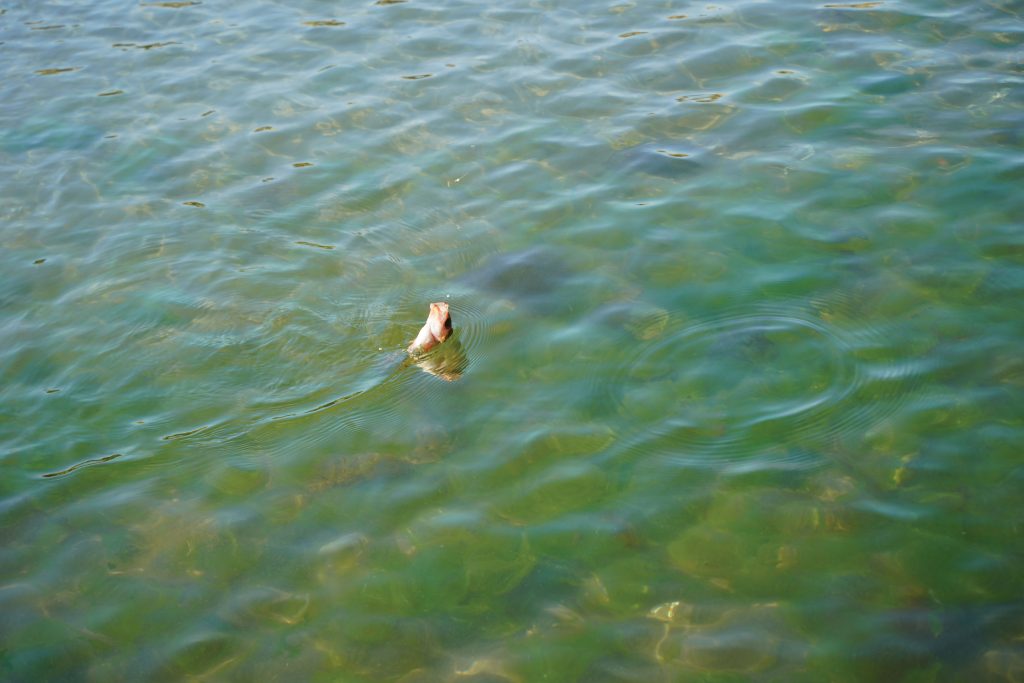
rockfish made for a nice meal back home in
Nagano Prefecture. For Sawa, it felt like the old
days with Dad back in California.
(LANCE SAWA)
Whenever I fish somewhere new I try to talk to anyone else who’s fishing. Local knowledge is always the best intel, I have found over the years. They can give you pointers that no one else can.As I was doing this, I saw a familiar face; it was the same woman from the store and she was fishing the area she had suggested to me. It was great to see her fishing there.I asked if she had caught anything. She said she ate lunch first, so she’d just gotten there but hadn’t caught anything yet. I thanked her again for all the earlier advice.The new spot had even more breakwalls protecting the fishing area. I started to again walk the beach until I got to one breakwall, fished it and got a light tap, but whatever was on the other end quickly dropped it.I tried again almost on top of the breakwall and a fish took the bait this time. I was engaged in another quick fight and this time it was a small squarespot rockfish. This too went into the bucket with the flounder.This fish made me think maybe everything was still hiding in between the rocks because of the storm. I continued to fish that breakwall, but didn’t get anything else. The first time I had to cast far away, but it too had a squarespot for me. One last breakwall landed me two more squarespots, one close to the beach and another that bit almost as far as I could cast out. But with all my bait used, it was time to head home.
AFTER AN HOUR ON the road I could see my local mountain again. It still had snow on its peak, even though I had been baking in the beach sun all day. A mountain Sakura cherry blossom tree along the road home was in full bloom, even though places like Tokyo were long done with the Sakura season.At home I started cleaning the fish as Nico came home from school. He likes to sit and watch me clean them. He knows all the fish names, even if I have never brought that type of fish home before.There was just enough fish for one meal, which is perfect because my son loves to eat the fish I bring home. I didn’t catch any sillago this trip, but now I know where and how to catch them for next time. Maybe I should buy some grub-tail lures when I get back out and see what I can catch with them.


